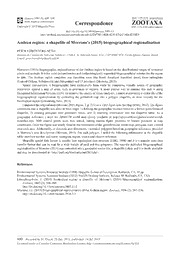
Andean region: a shapefile of Morrone’s (2015) biogeographical regionalisation PDF
Preview Andean region: a shapefile of Morrone’s (2015) biogeographical regionalisation
Zootaxa 3985 (4): 600–600 ISSN 1175-5326 (print edition) ZOOTAXA www.mapress.com/zootaxa/ Correspondence Copyright © 2015 Magnolia Press ISSN 1175-5334 (online edition) http://dx.doi.org/10.11646/zootaxa.3985.4.9 http://zoobank.org/urn:lsid:zoobank.org:pub:A1E67785-34EB-4E30-8742-F14261E358E9 Andean region: a shapefile of Morrone’s (2015) biogeographical regionalisation PETER LÖWENBERG-NETO Instituto de Ciências da Vida e da Natureza – UNILA. Av. Tancredo Neves, 6731, CEP 85867-970, Foz do Iguacu, Parana, Brazil. E-mail: [email protected] Morrone's (2015) biogeographic regionalisation of the Andean region is based on the distributional ranges of terrestrial plants and animals. It is the most comprehensive and methodologically supported biogeographical scheme for the region to date. The Andean region comprises one transition zone (the South American transition zone), three subregions (Central Chilean, Subantarctic and Patagonian) and 15 provinces (Morrone, 2015). Spatial comparisons in biogeography have traditionally been made by comparing visually points of geographic occurrence against a map of areas, such as provinces or regions. A more precise way to conduct this task is using Geospatial Information Systems (GIS). To improve the quality of future analyses, I aimed at providing a vector file of the biogeographical regionalisation by converting the published map into a polygon shapefile, as done recently for the Neotropical region (Löwenberg-Neto, 2014). I imported the original map (Morrone 2015, Figure 2, p. 211) as a TIFF figure into ArcMap (ESRI, 2012). The figure conversion into a shapefile was done in three steps: 1) defining the geographic location based on a former georeferenced shapefile; 2) creating polygons over provinces limits; and 3) inserting information into the shapefile table. As a geographic reference, I used the APRSTM world map (freely available at http://aprsworld.net/gisdata/world/world- modified.zip). 2000 control points were then added, linking known figure positions to known positions in map coordinates. Once the figure was totally fitted to the boundaries of the georeferenced world map, polygons were created over each area. Additionally, to diminish area distortions, I revisited polygons based on geographic references provided in Morrone’s area descriptions (Morrone, 2015). For each polygon, I added the following information in the shapefile table: province number and name, subregion, region, source and citation reference. Shapefile spatial data format is smaller than topological data structure (ESRI, 1998) and it is a popular open data transfer format that can be read by a wide variety of paid and free programs. The recently published biogeographical regionalisation of Morrone (2015) was converted into a geospatial vector file, a shapefile (.shp), and it is freely available and may be downloaded at <http://purl.org/biochartis/and2015shp>. References Environmental Systems Resource Institute (1998) Shapefile Technical Description. Redlands, CA, 30 pp. Environmental Systems Resource Institute (2012) ArcGIS Desktop Sofware, Release 10. Redlands, CA, USA. Löwenberg-Neto, P. (2014) Neotropical region: a shapefile of Morrone’s (2014) biogeographical regionalization. Zootaxa, 3802 (2), 300–300. http://dx.doi.org/10.11646/zootaxa.3802.2.12 Morrone, J.J. (2015) Biogeographical regionalisation of the Andean region. Zootaxa, 3936 (2), 207–236. http://dx.doi.org/10.11646/zootaxa.3936.2.3 600 Accepted by M. Ebach: 23 Jun. 2015; published: 14 Jul. 2015 Licensed under a Creative Commons Attribution License http://creativecommons.org/licenses/by/3.0
